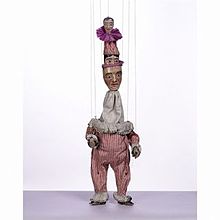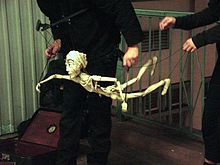- Marionette
-
This article is about the type of puppet. For other uses, see Marionette (disambiguation).
A marionette is a puppet controlled from above using wires or strings depending on regional variations. A marionette's puppeteer is called a manipulator.[1] Marionettes are operated with the puppeteer hidden or revealed to an audience by using a vertical or horizontal control bar in different forms of theatres or entertainment venues. They have also been used in films and on television.
Contents
Etymology
In French. marionette = "little Mary". One of the first figures to be made into a marionette was the Virgin Mary, hence the name.[1]
Ancient times
Main article: PuppetryPuppetry is an ancient form of performance. Some historians claim that they pre-date actors in theatre.[citation needed] There is evidence that they were used in Egypt as early as 2000 BC when string-operated figures of wood were manipulated to perform the action of kneading bread, and other string controlled objects. Wire controlled, articulated[specify] puppets made of clay and ivory have been found in Egyptian tombs. Marionette puppetry was used to display rituals and ceremonies using these string-operated figurines back in ancient times and is used today.[specify]
Though the Greeks left few physical examples of puppets, their literature suggests that puppetry was important. The oldest written record on puppetry can be found in the writings of Xenephon dating from around 422 BC. The Greek word usually translated as "puppets" is neurospasta, which means "string-pulling", from nervus, meaning either sinew, tendon, muscle, string, or wire, and span, to pull. Aristotle compared pulling strings to control heads, hands and eyes, shoulders and legs[citation needed]. Archimedes is known to have worked with marionettes.[citation needed] Plato's work is full of references to puppeteering. The 'Iliad' and the 'Odyssey' were presented using puppetry.[specify] Herodotus wrote that during festivals to honour Osiris, female priests carried statues which had moving arms activated by strings.
In ancient Greece and Rome clay and ivory dolls, dated from around 500 BC, were found in children's tombs. These dolls had articulated arms and legs, some of which had an iron rod extending up from the tops of their heads. This rod was used to manipulate the doll from above, exactly as is done today in Sicilian puppetry. A few of these dolls had strings in place of the rods. Some authorities believe these ancient figures were mere toys and not puppets due to their small size.[citation needed]
The Indian word sutradhara refers to the show-manager of theatrical performances (or a puppet-player), and also means literally "string-puller" or "string-holder".
Middle Ages and Renaissance
Italy is considered by many to be the early home of the marionette thanks to the influence of Roman puppetry. Xenophon and Plutarch refer to them. The Christian church used marionettes to perform morality plays. It is believed that the term marionette' emerged around 1600. Comedy sneaked into the plays as time went by and ultimately led to an edict banning puppetry from the church. Puppeteers responded by setting up stages outside cathedrals and became ever more ribald and slapstick. Out of this grew the Italian comedy called commedia dell'arte. Puppets were used at times in this form of theatre. Sometimes Shakespeare's plays were performed using marionettes instead of actors.
Sicilian marionettes
The sides of donkey carts are decorated with intricate, painted scenes from the Frankish romantic poems, such as The Song of Roland; these same tales are enacted in traditional puppet theatres featuring hand-made marionettes of wood, this art is called Opira dî pupi (Opera of the puppets) in Sicilian. The opera of the puppets and the Sicilian tradition of cantastorî (singers of tales) are rooted in the Provençal troubadour tradition in Sicily during the reign of Frederick II, Holy Roman Emperor, in the first half of the 13th century. A great place to see this marionette art is the puppet theatres of Palermo, Sicily.
Marionette operas
In the eighteenth century, operas were specifically composed for marionettes. Mozart as a child had seen marionettes. Gluck, Haydn, de Falla and Respighi all composed adult operas for marionettes. Lewis Carroll composed marionette operas and plays for his siblings' entertainment. Today in Salzburg in Austria, the Salzburg Marionette Theatre still continues the tradition of presenting full length opera using marionettes in their own purpose built theatre.
Marionettes in modern times
Marionettes are sometimes referred to as "puppets", but the term "marionettes" is more precise, distinguishing them from other forms of puppetry, such as finger, glove, rod and shadow puppetry.
In the UK the renaissance of Marionettes during the late 19th and early 20th century was driven by W. H. Whanslaw and Waldo Lanchester, two of the co-founders of the British Puppet and Model Theatre Guild. The only purpose-built UK marionette theatre is The Harlequin Puppet Theatre (built 1958) in Rhos on Sea, North Wales, Founded by the late Eric Bramall FRSA and continued by Chris Somerville. Other theatres that occasionally perform with marionettes are the Little Angel Theatre founded by John and Lyndie Wright in Islington, London, Whose first ever show The Wild Night Of The Witches was a marionette play, It opened the theatre in 1961 and was revived for the 50th anniversary in 2011 The Norwich Puppet Theatre founded by Ray & Joan DaSilva sometimes present marionette shows and the Puppet Theatre Barge continue to perform using long string marionettes throughout the year, founded by Gren Middleton and Juliet Rogers The barge is based in Little Venice, London during the winter months and tours to places such as Richmond Upon Thames during the summer.
In Scotland, Dr Malcolm Knight has championed the art form and over the last 25 years the Scottish Mask and Puppet Centre[2] has acted as a catalyst, a lead agency, and as a resource centre for all those with an interest in mask and puppet theatre.
In Austria the Salzburg Marionette Theatre was founded in 1913 by Professor Anton Aicher. Aicher was heavily influenced by Count Franz Pocci who founded the Munich Marionette Theatre in Germany in 1855. Today, the Salzburg Marionette Theatre is under the artistic direction of his granddaughter, Gretel Aicher, who commented on her lasting interest in marionettes, "What then is the fascination of a life with marionettes? Is it the pleasure of performing? The appeal of mastering an 'instrument' to the point of virtuosity? The transformation of one's own self? For me, it is the process of emphathising with mind and soul, of feeling at one with music and movement that bring these much loved creatures to life. The Salzburg Marionette Theatre performs mainly operas such as Die Fledermaus and The Magic Flute and a small number of ballets such as The Nutcracker. The Salzburg Marionette Theatre productions are aimed for adults although children are welcome. There is also a marionette theatre at Schoenbrunn Palace in Vienna. Marionette theatre also had a very long history in entertainment in Prague,
In the Czech Republic Marionette theatre has a very long history in entertainment in Prague, An important organisation is the National Marionette Theatre. Its repertoire mainly features a marionette production of Mozart's famous Don Giovanni. The production has period costumes and a beautifully designed eighteenth century setting. There are numerous other companies including, Buchty a Loutky ("Cakes and Puppets") founded by Marek Bečka. Rocky IX and Tibet are just two works in the repertoire.[3]
In Australia, like in many other countries, there is a continuing tradition of marionette puppetry. Norman Hetherington OAM, Peter Scriven, founder of the Marionette Theatre of Australia, and Richard Bradshaw OAM are notable puppeteers.
In France, the most famous marionette is Guignol (hand marionette created in Lyon in 1808). In Picardie (France), Lafleur is a marionette from Amiens. The Cabotans d'Amiens are hand carved, using wood, with a central rod and strings for the arms and legs.
Television and film
 The 1952 Andy Pandy title card. The card was not actually a card as the blocks turned to reveal the title one block at a time.
The 1952 Andy Pandy title card. The card was not actually a card as the blocks turned to reveal the title one block at a time. Howdy Doody, famous television marionette.
Howdy Doody, famous television marionette.
With the rise in popularity of television and film, marionettes found a rise in popularity especially in children's programming. The story of Pinocchio and its Disney adaptation (Pinocchio), which was released in 1940, is a story about a marionette. In 1947, Howdy Doody introduced marionettes to Saturday morning television, with Howdy Doody (the main character) being a marionette, as well as some other characters.
In the 1950s, Bil Baird and Cora Eisenberg presented a great number of marionette shows for television, and were also responsible for the Lonely Goatherd sequence from the classic film The Sound of Music. Bil Baird also wrote a classic book on his work.[4] In Australia, a program called Mr. Squiggle, using a marionette central character of the same name, ran for just over 40 years (1959–1999). Another program for children using puppetry was the Magic Circle Club featuring puppets Cassius Cuckoo and Leonardo de Funbird.
From the 1940's onwards, the BBC in the United Kingdom, produced a wide series of marionette programmes for children and then created The BBC Televison Puppet Theatre based in Lime Grove Studios from 1955 - 1964, Usually under the title Watch With Mother The various programmes included Whirligig'The Woodentops, Bill and Ben, Muffin The Mule, Rubovia a series created by Gordon Murray and Andy Pandy. Later in the 1960s, Gerry Anderson with his wife, Sylvia Anderson and colleagues made a number of hit series, Fireball XL5, Stingray and Thunderbirds, which pioneered a technique combining marionettes and electronics. This allowed for radio control moving of the mouth of a marionettes. The technique was patented and called "supermarionation". The programs have been shown all around the world and are now widely distributed on DVD. Anderson also made two films, Thunderbirds Are Go and Thunderbird 6.[5] During the 1970's in the UK TV series using marionettes include The Adventures of Rupert Bear, Mumfie and Cloppa Castle. Some marionettes appear in Pipkins namely Octavia Ostrich. More recently marionettes are starting to re emerge on the Tv screen, Coca Cola Have used marionettes to create a series of adverts based in an office and music videos use them regularly as metaphors.
Team America: World Police is a 2004 movie made by South Park creators Matt Stone and Trey Parker which uses the same style of supermarionation as Thunderbirds. Matt Stone and Trey Parker dubbed their version "Supercrappymation" due to the fact they intentionally left the strings visible, among other reasons.
Also appearing in 2004 was the full-length, award-winning marionette fantasy film Strings, directed by Dane Anders Rønnow Klarlund.
Pixar uses its own proprietary software called Marionette to create its animations but this has nothing to do with puppetry except in name.
Marionettes are featured in the 1999 film, Being John Malkovich. John Cusack played a manipulator who referred to himself as a puppeteer.
A marionette was also used in the Doctor Who episode "The Shakespeare Code".
Types of marionette control bar
Chinese / Asian Paddle control
This type of control has many strings attached to a rounded rectangular paddle with a short handle, all the strings are attached and hang from the outer edge of the paddle and are used by selecting each string with the opposite hand and pulling to control the figure which hangs below
Horizontal control
This control is a bar which is held in the hand in a horizontal plane, there can be numerous bars attached to it at right angles to the central bar which the Hands, shoulders, back, etc. are all attached to. A smaller plate is usually hung under the main bar and this carries the head strings. a clip usually holds the leg bar which can be detachable for leg movement. This style of control is generally used in the USA for human figures and is also known as the American control, A similar control is almost universally used for quadruped animals as it emulates the basic shape of the animal, rocking it from side to side will control the leg movements in unison when strung correctly. A variant of this style of control is also used by the Salzburg Marionette Theatre in Austria for its human characters.
Vertical Control
This type of control is an upright bar which has various smaller bars inserted at right angles from which the head, Shoulder, Back etc. strings etc. are attached to. This control usually has a detachable leg bar which controls walking when held in the opposite hand. The arms are controlled by wires which are inserted in to a hole in the shaft bent at approximately 45 degrees to the shaft and hang loosely with a loop at the end to attach the hand strings, these are then moved by the fingers holding the main shaft. A tilt of the main upright, controls the head and body with a fine nuance, This type of control is usually called the Bristish control Another variation of the Vertical control is found in eastern Europe usually a rigid wire rod extends from the centre of the head upwards and fixed rigidly to the control, The leg bar is inserted through the main upright but pivots on a pin to allow movement of the legs.
Styles of marionettes
Sicilian marionettes
Sicilian marionettes are among the simplest marionettes to operate. They are usually carved out of wood and have a sturdy rod which extends up through the body into the head. This rod, and one string attached to the hand, controls the manipulation of the puppet.
Czech marionettes
Czech rod marionettes are similar to Sicilian ones though they are more complex. They are hand carved, usually using lime wood. The marionettes have the central rod like the Sicilian marionette but also have strings for the arms and legs. Sometimes they also use string to control a mouth or movable ears. These require more skilled manipulation. Czechs also have marionettes that have no central rod and strings that are attached to the head, shoulders and back. These are the most difficult marionettes to manipulate due to the absence of the central rod. Miroslav Trejtnar is an acknowledged master puppeteer and teacher of traditional Czech marionette making skills.
Burmese marionettes
Main article: Yoke théBurmese marionettes are all string operated and are a popular art in Myanmar. Marionettes are called Yoke thé (lit. miniatures) and are almost always performed in operas. A Burmese marionette troupe must have 27 characters, including a king, animals such as horse, elephant, tiger, monkey and parrot, ministers, prince and princess and buffoons[6] A hsaing waing, a traditional Burmese orchestra usually provides the music. Burmese marionettes are very intricate and dexterous as they employ 18 (for male characters) or 19 (for female) wires, each puppet controlled only by one puppeteer.
See also
- Bunraku, traditional Japanese puppet theater
- Buz-baz, traditional Afghan puppet show
- Digital puppetry, animated objects in a virtual environment rendered in real-time by computers
- Harlequin Puppet Theatre, Britain's first purpose-built marionette theatre
- Mr. Squiggle, Australian marionette
Further reading
- Baird, Bil (1966). The Art of the Puppet. Plays. ISBN 10 0823800679.
- Binyon, Helen (1966). Puppetry Today. London: Studio Vista Limited.
- Beaton, Mabel; Les Beaton (1948). Marionettes: A Hobby for Everyone. New York.
- Currell, David (1992). An Introduction to Puppets and Puppetmaking. London: New Burlington Books, Quintet Publishing Limited. ISBN 1 85348 389 3.
- Dubska, Alice; Jan Novak, Nina Malikova, Marie Zdenkova (2006). Czech Puppet Theatre. Prague: Theatre Institute. ISBN 80 7008 199 6.
- Latshaw, George (2000). The Complete Book of Puppetry. London: Dover Publications. ISBN 978-048640-952-8.
- Robinson, Stuart; Patricia Robertson (1967). Exploring Puppetry. London: Mills & Boon Limited.
- Sinclair, Anita (1995). The Puppetry Handbook. Richmond, Victoria, Australia: Richard Lee Publishing. ISBN 0 646 39063 5.
- Suib, Leonard; Muriel Broadman (1975). Marionettes Onstage!. New York: Harper & Row, Publishers. ISBN 0 06 014166 2.
References
- ^ Puppetry Today by Helan Binyon, p.11
- ^ "Scottish Mask and Puppet Centre". http://www.scottishmaskandpuppetcentre.co.uk/.
- ^ Czech Puppet Theatre by Alice Dubska, p. 56
- ^ The Art of the Puppet by Bil Baird
- ^ "Cult - Gerry Anderson - Thunderbirds". BBC Online. http://www.bbc.co.uk/cult/anderson/thunderbirds/page1.shtml.
- ^ Khin Zaw, U (1981). Burmese Culture: General and Particular. Yangon: Sarpay Beikman Corporation. pp. 14–28. ISBN none.
External links
Categories:- Puppetry
- French words and phrases
- French loanwords
Wikimedia Foundation. 2010.






